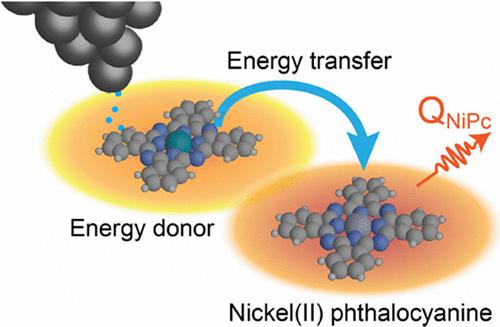当前位置:
X-MOL 学术
›
J. Am. Chem. Soc.
›
论文详情
Our official English website, www.x-mol.net, welcomes your feedback! (Note: you will need to create a separate account there.)
Activating the Fluorescence of a Ni(II) Complex by Energy Transfer
Journal of the American Chemical Society ( IF 15.0 ) Pub Date : 2024-03-21 , DOI: 10.1021/jacs.3c07716 Tzu-Chao Hung 1, 2 , Yokari Godinez-Loyola 3, 4 , Manuel Steinbrecher 1 , Brian Kiraly 1 , Alexander A. Khajetoorians 1 , Nikos L. Doltsinis 5 , Cristian A. Strassert 3, 4, 6 , Daniel Wegner 1
Journal of the American Chemical Society ( IF 15.0 ) Pub Date : 2024-03-21 , DOI: 10.1021/jacs.3c07716 Tzu-Chao Hung 1, 2 , Yokari Godinez-Loyola 3, 4 , Manuel Steinbrecher 1 , Brian Kiraly 1 , Alexander A. Khajetoorians 1 , Nikos L. Doltsinis 5 , Cristian A. Strassert 3, 4, 6 , Daniel Wegner 1
Affiliation

|
Luminescence of open-shell 3d metal complexes is often quenched due to ultrafast intersystem crossing (ISC) and cooling into a dark metal-centered excited state. We demonstrate successful activation of fluorescence from individual nickel phthalocyanine (NiPc) molecules in the junction of a scanning tunneling microscope (STM) by resonant energy transfer from other metal phthalocyanines at low temperature. By combining STM, scanning tunneling spectroscopy, STM-induced luminescence, and photoluminescence experiments as well as time-dependent density functional theory, we provide evidence that there is an activation barrier for the ISC, which, in most experimental conditions, is overcome. We show that this is also the case in an electroluminescent tunnel junction where individual NiPc molecules adsorbed on an ultrathin NaCl decoupling film on a Ag(111) substrate are probed. However, when an MPc (M = Zn, Pd, Pt) molecule is placed close to NiPc by means of STM atomic manipulation, resonant energy transfer can excite NiPc without overcoming the ISC activation barrier, leading to Q-band fluorescence. This work demonstrates that the thermally activated population of dark metal-centered states can be avoided by a designed local environment at low temperatures paired with directed molecular excitation into vibrationally cold electronic states. Thus, we can envisage the use of luminophores based on more abundant transition metal complexes that do not rely on Pt or Ir by restricting vibration-induced ISC.
中文翻译:

通过能量转移激活 Ni(II) 配合物的荧光
由于超快系间窜越 (ISC) 和冷却到暗金属中心激发态,开壳层 3 d金属配合物的发光通常会被猝灭。我们证明了通过低温下其他金属酞菁的共振能量转移,在扫描隧道显微镜 (STM) 的连接处成功激活了单个镍酞菁 (NiPc) 分子的荧光。通过结合 STM、扫描隧道光谱、STM 诱导发光和光致发光实验以及时间相关的密度泛函理论,我们提供了 ISC 存在激活障碍的证据,在大多数实验条件下,该激活障碍已被克服。我们表明,在电致发光隧道结中也是如此,其中对吸附在 Ag(111) 基板上的超薄 NaCl 去耦膜上的单个 NiPc 分子进行了探测。然而,当通过 STM 原子操作将 MPc(M = Zn、Pd、Pt)分子放置在 NiPc 附近时,共振能量转移可以激发 NiPc,而无需克服 ISC 激活势垒,从而产生 Q 带荧光。这项工作表明,通过设计低温局部环境并结合定向分子激发进入振动冷电子态,可以避免暗金属中心态的热激活群体。因此,我们可以设想使用基于更丰富的过渡金属配合物的发光体,这些配合物不依赖于 Pt 或 Ir,通过限制振动引起的 ISC 来实现。
更新日期:2024-03-21
中文翻译:

通过能量转移激活 Ni(II) 配合物的荧光
由于超快系间窜越 (ISC) 和冷却到暗金属中心激发态,开壳层 3 d金属配合物的发光通常会被猝灭。我们证明了通过低温下其他金属酞菁的共振能量转移,在扫描隧道显微镜 (STM) 的连接处成功激活了单个镍酞菁 (NiPc) 分子的荧光。通过结合 STM、扫描隧道光谱、STM 诱导发光和光致发光实验以及时间相关的密度泛函理论,我们提供了 ISC 存在激活障碍的证据,在大多数实验条件下,该激活障碍已被克服。我们表明,在电致发光隧道结中也是如此,其中对吸附在 Ag(111) 基板上的超薄 NaCl 去耦膜上的单个 NiPc 分子进行了探测。然而,当通过 STM 原子操作将 MPc(M = Zn、Pd、Pt)分子放置在 NiPc 附近时,共振能量转移可以激发 NiPc,而无需克服 ISC 激活势垒,从而产生 Q 带荧光。这项工作表明,通过设计低温局部环境并结合定向分子激发进入振动冷电子态,可以避免暗金属中心态的热激活群体。因此,我们可以设想使用基于更丰富的过渡金属配合物的发光体,这些配合物不依赖于 Pt 或 Ir,通过限制振动引起的 ISC 来实现。



























 京公网安备 11010802027423号
京公网安备 11010802027423号